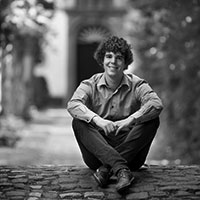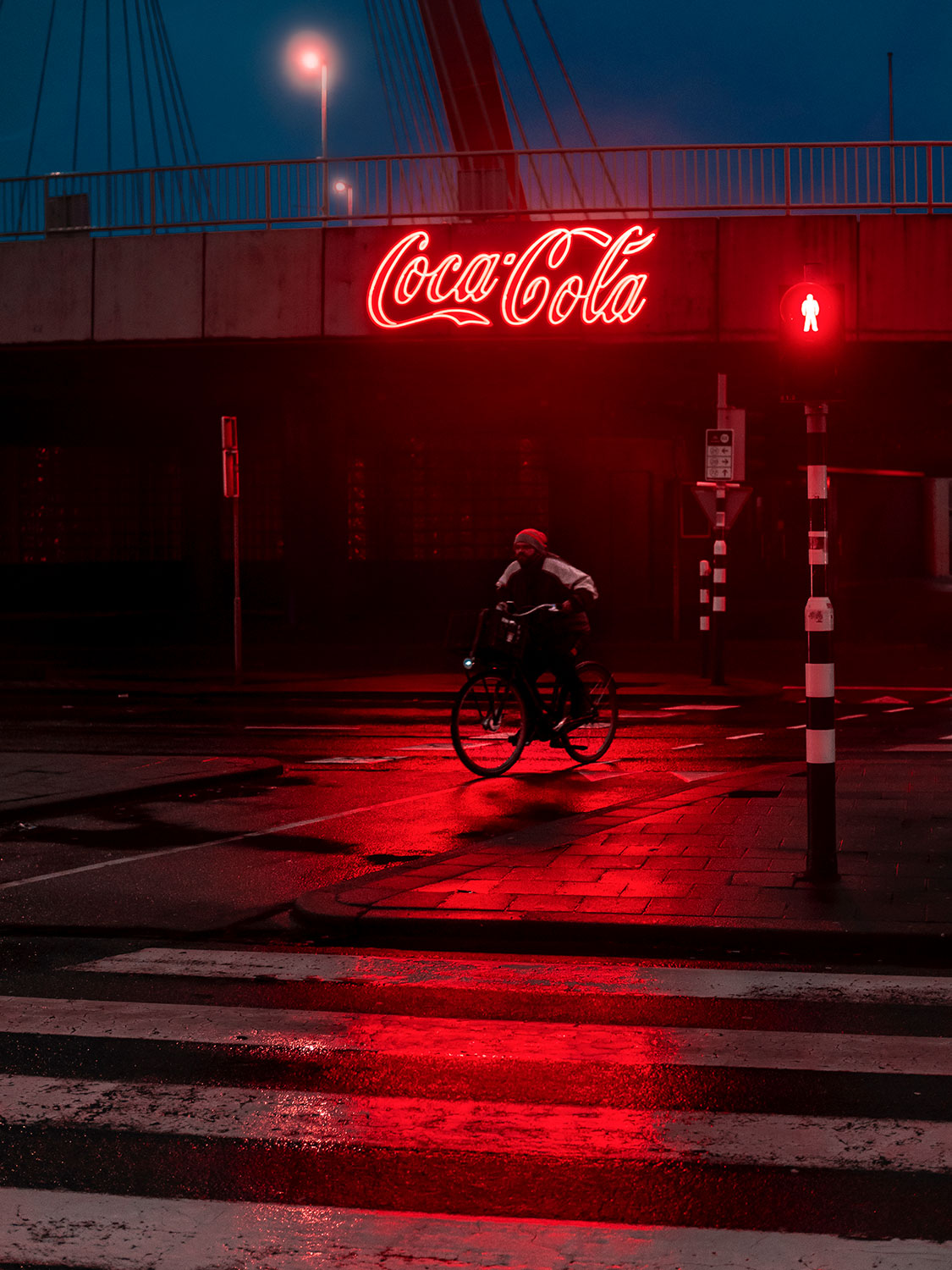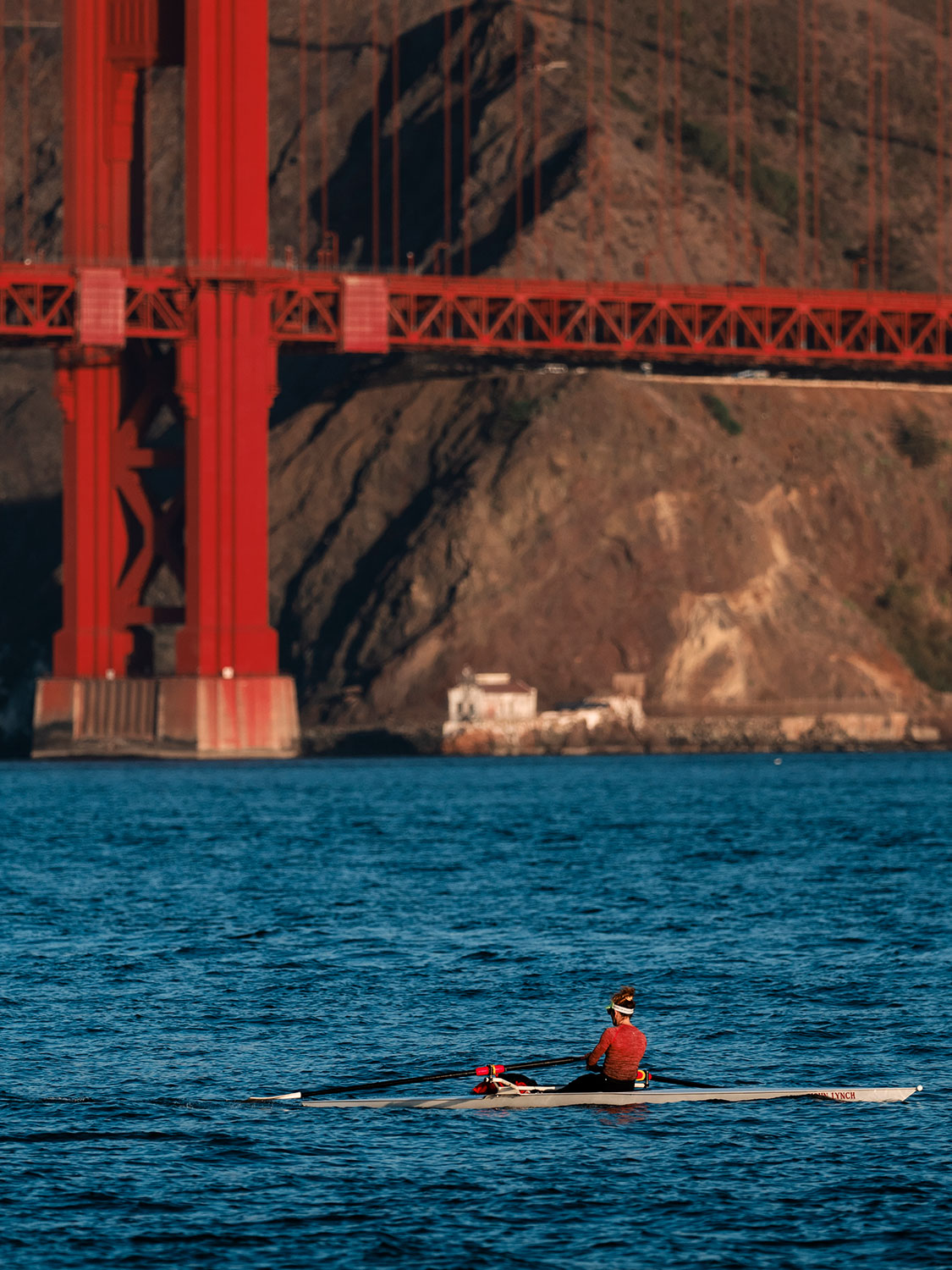Street photography done differently
I’m a stubborn street photographer that likes to go his own way. I’ve been into street photography since 2010, and all these years, I’ve had one main goal: I want to create images that look so perfect that one would think that they’re staged or maybe even photoshopped. I want the viewers to be able to imagine the story. Everything I do, leads back to this goal. In this article, I’ll first discuss one picture that summarises my story, then I’ll explain why I love street photography, what gear I use, who I’m inspired by and what I’d like to achieve.
One photo that summarises my story
This photo is a perfect example of my work. It was the first time I used the Panasonic Leica 200mm f/2.8 on a sunset stroll just outside of Nijmegen. I saw the silhouette of a jogger on the stairs that lead to the bridge. I took a photo of the guy and started thinking about how I could improve the image. I tried different angles and various compositions. And when everything was to my liking, I waited.
I didn’t know exactly what I was waiting for, but I had a feeling I could get more out of it than just one silhouette. These stairs weren’t used that much, so I had to wait almost half an hour until there appeared people simultaneously on both sides of the stairs. I spotted a cyclist on the bridge in the corner of my eye and decided to wait until the biker would be exactly in the middle of the frame.
For me, this photo embodies everything I love about street photography: choosing the perfect background for your image and then it’s a combination of patience, timing and a little bit of luck.
Why street photography?
When I just started photography, I tried many different genres: I discovered macro photography, tried shooting birds with a telephoto lens and explored architecture and landscape photography. However, the moment I hit upon street photography, I was sold.
It feels kinda like a game. For me, the perfect street photo is like an urban landscape with the right person at the right moment in the right place in the frame, as the cherry on the cake. And as much as you can control the place and the timing, you can’t control people. So it’s a combination of predictability and perfect timing. When you’re able to combine all these elements in one split second, well, that feels wonderful!
RIGHT: Olympus E-M5 MK II . Olympus M.Zuiko 12-40mmF2.8 @40mm . F/5.6 . 1/2000” . ISO 200
What gear do I use?
I started out with a Canon DSLR at first. When I was 17, I started working at a camera store, and there I could try out all the different cameras from all different brands. I was really charmed by the compactness of the Olympus E-M5. Furthermore, I was really impressed by the sharpness of the lenses, even when shooting wide open.
I’ve always liked to try different lenses for my photography. When other photographers tell me that I have to take street photos with a 17mm lens (35mm equivalent), it only makes me wonder what could be achieved with a longer lens. I’m a bit stubborn like that. I started out with the 45mm f/1.8 and followed this up with the weather-sealed 60mm f/2.8 Macro and the 75mm f/1.8. Last summer, I bought the extreme Panasonic Leica 200mm f/2.8.
RIGHT: Olympus E-M5 MK II . Olympus M.Zuiko 12-40mmF2.8 @40mm . F/2.8 . 1/8000” . ISO 64
Although I also use the 12-40mm f/2.8 PRO for the wide-angle to the standard range, I’ve grown to like telephoto lenses for street photography. For me, it has nothing to do with keeping at a safe distance, it’s all about the characteristics of such a lens. A telephoto lens makes for a lot of compression.
Therefore you can make use of the so-called Z-axis: elements that are quite far apart can look really close due to the compression of your telephoto lens. You can use this to combine different elements in a way you could never do with a wide-angle or standard lens.
RIGHT: Olympus E-M5 MK II . Leica DG 200mmF2.8 . F/4.0 . 1/3200” . ISO 200
Which photographers inspire me?
One of my main inspirations is Steve McCurry. Although I wouldn’t describe him as a street photographer, I’ve learned a lot from his brilliant usage of colour. Lots of street photographers stick to black and white, but I like the atmosphere colour adds. McCurry is as good as they get when it comes to combining different colours and making them pop.
RIGHT: Olympus E-M5 MK II . Olympus M.Zuiko 75mmF1.8 . F/2.8 . 1/320” . ISO 200
Henri Cartier-Bresson is one of the best street photographers of all-time, and I’ll never get enough of his sense of timing and composition. I also like René Burri. Cartier-Bresson was a mentor to Burri, and he always told him to stick with lenses in between 35mm and 90mm (which would be 17 – 45mm at MFT). One day Burri showed him a photo and Cartier-Bresson said he really loved it.
Burri ran outside and shouted “Hah!”. He never told Cartier-Bresson why, but the photo he showed was taken with a 180mm lens! He is one of the first street photographers that used telephoto lenses. Other pioneers worth checking out are André Kertész and Saul Leiter.
What kind of street photographer do I want to be?
I’ve been working to create my own style for years now. As I stated earlier, for me, it’s about images of everyday moments that look out of the ordinary. My only rule is that there has to be a person in the photo that never noticed me and is completely in the moment because of that.
I challenge myself to look beyond sunny days in metropolitan cities, taking black and white pictures with a 35mm equivalent lens. I use lenses from wide-angle to super-telephoto, take photos in cities and other urban areas, but also in the middle of nature or on a boat. I go for my walks during rain or sunshine, the golden hour or in the middle of the day, no matter the season. Afterwards, I sit down with a nice cup of coffee and choose whether the pictures I took look better in colour or black and white.
RIGHT: Olympus E-M5 MK II . Olympus M.Zuiko 60mmF2.8 . F/2.8 . 1/250” . ISO 200
What do I want to achieve?
For me, photography is some sort of meditation. When I’m out with my camera, I’m not worrying about day to day stuff. I stop thinking about work, I forget that the windows need cleaning and just focus on everything I see.
Last year I gave my first street photography workshop in Nijmegen, and it was really great. Talking about photography and helping others to get better is really fulfilling.
But I’m ambitious as well: I want to continuously improve as a photographer, and one day I would love to be known as one of the best Dutch street photographers. It’s okay to have an audacious goal, right? In the meantime, I just walk out of my door, not knowing what I’ll run into.
RIGHT: Olympus E-M5 MK II . Olympus M.Zuiko 12-40mmF2.8 @17mm . F/2.8 . 1/2000” . ISO 200
RIGHT: Olympus E-M5 MK II . Olympus M.Zuiko 300mmF4.0 . F/4.0 . 1/2000” . ISO 200

Living in the Netherlands, Rutger is a street photographer who also teaches amateur photography courses and workshops. During the wedding season, you’re very likely to find him capturing the decisive moment. He frequently shares his work on Instagram and is happy to take you on a street photography tour in Dutch cities.

































